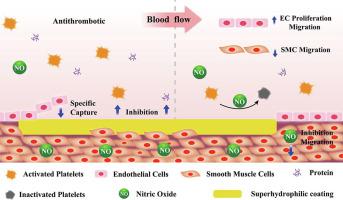Chemical Engineering Journal ( IF 13.3 ) Pub Date : 2021-06-22 , DOI: 10.1016/j.cej.2021.130932 Haoshuang Wu , Qing He , Li Li , Linhua Li , Zhongyi Zhou , Nuoya Chen , Ming Yang , Qingfeng Luo , Bo Zhang , Rifang Luo , Li Yang , Yunbing Wang

|
The achievement of the desired hemocompatibility, anti-inflammatory, and rapid endothelialization properties has significantly contributed to the success of implantable blood-contacting materials, especially vascular stents. In this study, we constructed a facile and versatile superhydrophilic coating via the stepwise deposition of metal/phenolic networks (MPNs) using a layer-by-layer assembly technique. Tannic acid and copper ions were employed for the fabrication of MPNs, and the surface roughness and the number of hydrophilic phenolic groups were gradually increased, ultimately leading to the generation of a superhydrophilic coating, where the copper ions were also effectively incorporated. Owing to the superhydrophilicity of the coating, the binding of serum adhesion proteins, such as albumin and fibrinogen, to the surface was strongly inhibited, thereby conferring a potent antithrombotic ability. In addition, a potent antioxidant and anti-inflammatory effects were achieved through the deposition of a large amount of residual phenolic hydroxyl groups on the surface. The incorporated copper ions could also mimic endothelial function through the continuously catalyzed decomposition of endogenous S-nitrothiols (RSNOs) to release nitric oxide (NO) in situ in a controlled manner. The synergistic contribution effect of NO and superhydrophilicity, further inhibited the adhesion/activation of platelets. The optimized coating significantly inhibited the adhesion and activation of platelets, selectively supported the adhesion of endothelial cells, and suppressed the proliferation of smooth muscle cells. Such superhydrophilic coating with the incorporation of copper ions adequately addressed the basic requirements of vascular stents, in terms of antithrombosis, anti-restenosis, and enhanced endothelialization in vivo, demonstrating a promising approach for the clinical application of vascular implants.
中文翻译:

可生物降解 PLA 支架上的一种简便且多功能的超亲水涂层,具有金属/酚类网络的逐步组装,用于模拟内皮功能
所需的血液相容性、抗炎和快速内皮化特性的实现对可植入血液接触材料的成功做出了重大贡献,尤其是血管支架。在这项研究中,我们通过使用逐层组装技术逐步沉积金属/酚醛网络(MPN)构建了一种简便且多功能的超亲水涂层。单宁酸和铜离子被用于制备 MPNs,表面粗糙度和亲水性酚基团的数量逐渐增加,最终导致超亲水涂层的产生,其中铜离子也被有效地掺入。由于涂层的超亲水性,血清粘附蛋白如白蛋白和纤维蛋白原的结合,表面被强烈抑制,从而赋予有效的抗血栓形成能力。此外,通过在表面沉积大量残留的酚羟基,实现了有效的抗氧化和抗炎作用。掺入的铜离子还可以通过持续催化分解内源性 S-硝基硫醇 (RSNO) 以释放一氧化氮 (NO) 来模拟内皮功能以受控方式就地。NO和超亲水性的协同贡献作用,进一步抑制了血小板的粘附/活化。优化的涂层显着抑制血小板的粘附和活化,选择性地支持内皮细胞的粘附,抑制平滑肌细胞的增殖。这种掺入铜离子的超亲水涂层充分满足了血管支架在抗血栓形成、抗再狭窄和增强体内内皮化方面的基本要求,为血管植入物的临床应用提供了一种有前景的方法。











































 京公网安备 11010802027423号
京公网安备 11010802027423号